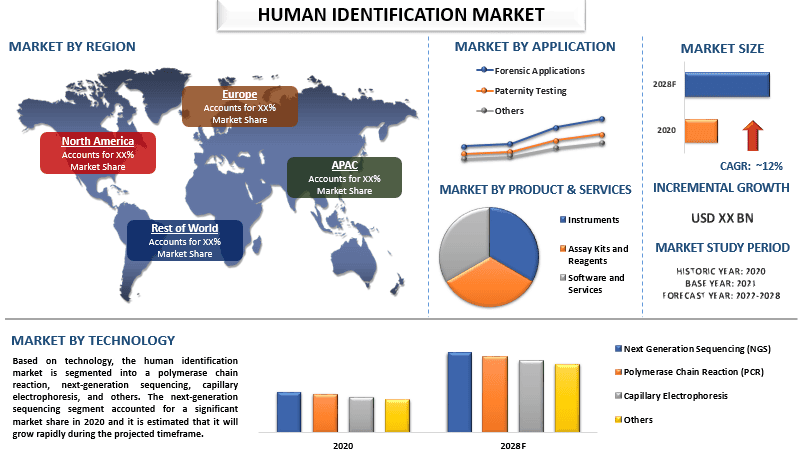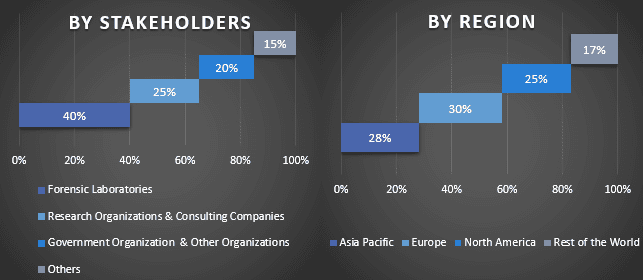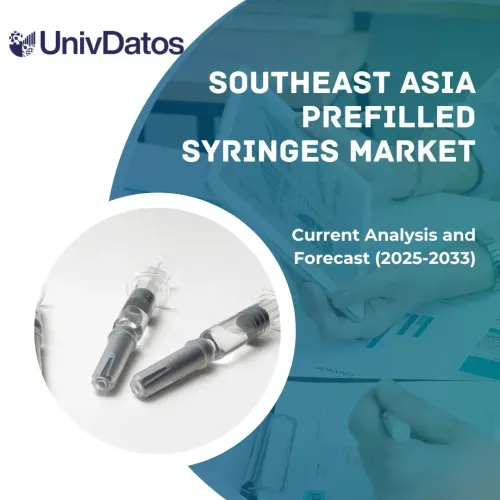- Home
- About Us
- Industry
- Services
- Reading
- Contact Us
Human Identification Market: Current Analysis and Forecast (2022-2028)
Emphasis on Technology (Polymerase Chain Reaction, Next-Generation Sequencing, Capillary Electrophoresis, and Others); Application (Forensic Applications, Paternity Testing, and Others); Product & Services (Instruments, Assay Kits & Reagents, and Software & Services); and Region/Country

Global Human Identification Market is expected to grow at a significant rate of around 12% during the forecast period. The global human identification market is anticipated to witness an uptick owing to the growing technological advancements in human identification systems and rising government funding and initiatives. For instance, in May 2020, the government of India acquired DNA testing kits for tracing the “purity of races” of its 1.4 billion population sparked outrage. INR 10 crore of funds have also been set aside for the project by the culture ministry of India. Furthermore, the rapidly increasing use of polymerase chain reaction (PCR) and next-generation sequencing (NGS) along with the rising application of PCR and NGS in the human identification market is also positively influencing the market growth. This is also leading to the increasing focus of many industry players to launch new and innovative products in the market. For example, in June 2020, Azure Biosystems launched the Azure Cielo Real-time PCR instrument, a 96-well qPCR machine that upholds Azure’s brand promise: high performance, compact design, and intuitive workflow.
Thermo Fisher Scientific Inc., QIAGEN, Promega Corporation, Agilent Technologies Inc. Illumina Inc., Bio-Rad Laboratories Inc., Eurofins Scientific, Hamilton Company, GENETEK Biopharma GmbH, Integenx Inc. are some of the key players in the market. Several M&As along with partnerships have been undertaken by these players to facilitate customers with hi-tech and innovative products/technologies.
Insights Presented in the Report
“Amongst technology, next-generation sequencing category to witness higher CAGR during the forecast period”
Based on technology, the human identification market is segmented into a polymerase chain reaction, next-generation sequencing, capillary electrophoresis, and others. The next-generation sequencing segment accounted for a significant market share in 2020 and it is estimated that it will grow rapidly during the projected timeframe as NGS is of extreme importance to medical practice as it provides a definitive diagnosis for many clinically heterogeneous diseases. Furthermore, rapid advancements in NGS technology and increasing applications of NGS in various sectors are also some other factors contributing to the growth of the segment.
“Amongst application, the forensic applications to hold a significant share in the market in 2020”
Based on application, the human identification market is classified into forensic applications, paternity testing, and others. The forensic application segment grabbed a significant market share in 2020 and is expected to grow considerably during the forecast period. The growth of this segment can be attributed to the wide use of human identification systems as there is a continuous increase in the number of crime incidences and government initiatives across the globe.
“Amongst product & services, assay kits & reagents to hold a significant share in the market in 2020”
Based on product & services, the market is fragmented into instruments, assay kits & reagents, and software & services. In 2020, the assay kits & reagents segment is expected to grab a considerable share of the human identification market owing to the regular use of various reagents & assay kits for DNA analysis. Furthermore, the launch of new assay kits and reagents is also driving the growth of this market segment in the coming years.
“North America to hold a significant share in the market”
In 2020, North America held a significant share of the global human identification market. The major factors such as favorable government initiatives, increased investments in research and development for DNA analysis coupled with technological advancements, the growing use of forensics coupled with the increasing demand for reducing the time and cost of DNA analysis in the region. For instance, in 2021, the Department of Justice’s Office of Justice Programs granted awards totaling more than USD 210 million to fund crime laboratories, support research, decrease DNA backlogs, and help law enforcement identify missing persons.
Reasons to buy this report:
- The study includes market sizing and forecasting analysis validated by authenticated key industry experts.
- The report presents a quick review of overall industry performance at one glance.
- The report covers an in-depth analysis of prominent industry peers with a primary focus on key business financials, product portfolio, expansion strategies, and recent developments.
- Detailed examination of drivers, restraints, key trends, and opportunities prevailing in the industry.
- The study comprehensively covers the market across different segments.
- Deep dive regional level analysis of the industry.
Customization Options:
The global human identification market can further be customized as per the requirement or any other market segment. Besides this, UMI understands that you may have your own business needs, hence feel free to connect with us to get a report that completely suits your requirements.
Table of Content
Research Methodology for the Human Identification Market Analysis (2022-2028)
Analyzing the historical market, estimating the current market, and forecasting the future market of the global human identification market were the three major steps undertaken to create and analyze the adoption of human identification in major regions globally. Exhaustive secondary research was conducted to collect the historical market numbers and estimate the current market size. Secondly, to validate these insights, numerous findings and assumptions were taken into consideration. Moreover, exhaustive primary interviews were also conducted, with industry experts across the value chain of the global human identification market. Post assumption and validation of market numbers through primary interviews, we employed a top-down/bottom-up approach to forecasting the complete market size. Thereafter, market breakdown and data triangulation methods were adopted to estimate and analyze the market size of segments and sub-segments of the industry pertains to. Detailed methodology is explained below:
Analysis of Historical Market Size
Step 1: In-Depth Study of Secondary Sources:
Detail secondary study was conducted to obtain the historical market size of the human identification market through company internal sources such as annual reports & financial statements, performance presentations, press releases, etc., and external sources including journals, news & articles, government publications, competitor publications, sector reports, third-party database, and other credible publications.
Step 2: Market Segmentation:
After obtaining the historical market size of the human identification market, we conducted a detailed secondary analysis to gather historical market insights and share for different segments & sub-segments for major regions. Major segments are included in the report as technology, application, and product & services. Further country-level analyses were conducted to evaluate the overall adoption of testing models in that region.
Step 3: Factor Analysis:
After acquiring the historical market size of different segments and sub-segments, we conducted a detailed factor analysis to estimate the current market size of the Human Identification market. Further, we conducted factor analysis using dependent and independent variables such as various technology, application, and product & services of human identification. A thorough analysis was conducted for demand and supply-side scenarios considering top partnerships, mergers and acquisitions, business expansion, and product launches in the Human Identification market sector across the globe.
Current Market Size Estimate & Forecast
Current Market Sizing: Based on actionable insights from the above 3 steps, we arrived at the current market size, key players in the global human identification market, and market shares of the segments. All the required percentage shares split, and market breakdowns were determined using the above-mentioned secondary approach and were verified through primary interviews.
Estimation & Forecasting: For market estimation and forecast, weights were assigned to different factors including drivers & trends, restraints, and opportunities available for the stakeholders. After analyzing these factors, relevant forecasting techniques i.e., the top-down/bottom-up approach were applied to arrive at the market forecast for 2028 for different segments and sub-segments across the major markets globally. The research methodology adopted to estimate the market size encompasses:
- The industry’s market size, in terms of revenue (USD) and the adoption rate of the human identification market across the major markets domestically
- All percentage shares, splits, and breakdowns of market segments and sub-segments
- Key players in the global human identification market in terms of products offered. Also, the growth strategies adopted by these players to compete in the fast-growing market
Market Size and Share Validation
Primary Research: In-depth interviews were conducted with the Key Opinion Leaders (KOLs) including Top Level Executives (CXO/VPs, Sales Head, Marketing Head, Operational Head, Regional Head, Country Head, etc.) across major regions. Primary research findings were then summarized, and statistical analysis was performed to prove the stated hypothesis. Inputs from primary research were consolidated with secondary findings, hence turning information into actionable insights.
Split of Primary Participants in Different Regions

Market Engineering
The data triangulation technique was employed to complete the overall market estimation and to arrive at precise statistical numbers for each segment and sub-segment of the global human identification market. Data was split into several segments & sub-segments post studying various parameters and trends in the areas of technology, application, and product & services in the global human identification market.
The main objective of the Global Human Identification Market Study
The current & future market trends of the global human identification market were pinpointed in the study. Investors can gain strategic insights to base their discretion for investments on the qualitative and quantitative analysis performed in the study. Current and future market trends determined the overall attractiveness of the market at a regional level, providing a platform for the industrial participant to exploit the untapped market to benefit from a first-mover advantage. Other quantitative goals of the studies include:
- Analyze the current and forecast market size of the human identification market in terms of value (USD). Also, analyze the current and forecast market size of different segments and sub-segments
- Segments in the study include areas of technology, application, and product & services.
- Define and analysis of the regulatory framework for the human identification
- Analyze the value chain involved with the presence of various intermediaries, along with analyzing customer and competitor behaviors of the industry.
- Analyze the current and forecast market size of the human identification market for the major region.
- Major countries of regions studied in the report include Asia Pacific, Europe, North America, and the Rest of the World.
- Company profiles of the Human Identification market and the growth strategies adopted by the market players to sustain in the fast-growing market
- Deep dive regional level analysis of the industry
Related Reports
Customers who bought this item also bought










